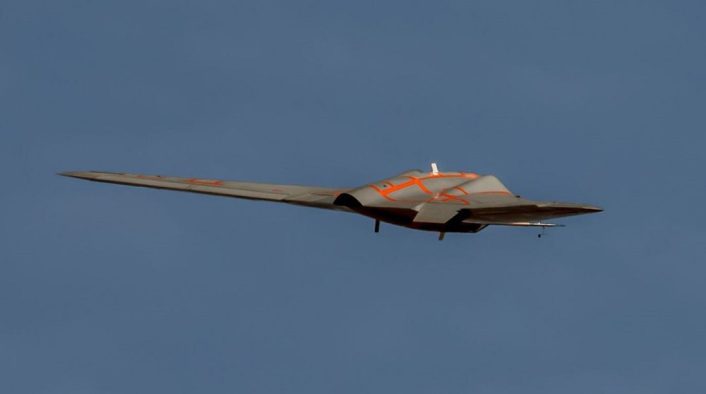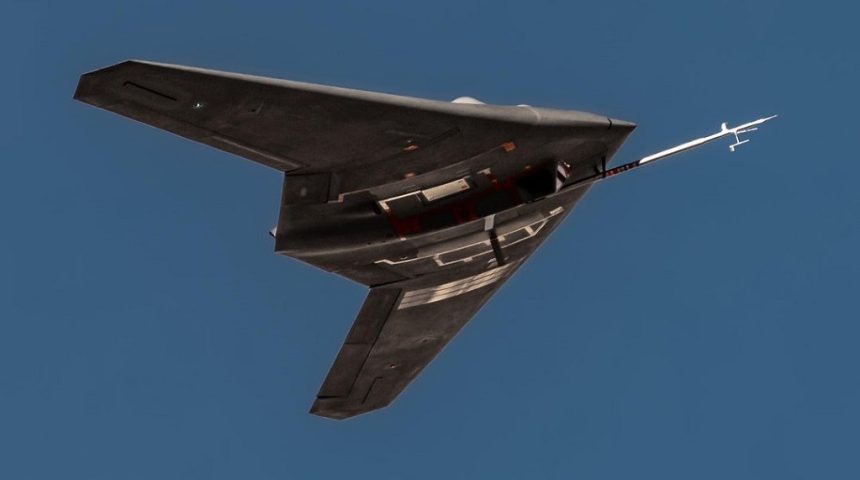The drone, apparently in a test configuration, was spotted over the desert south of Edwards Air Force Base.
The secretive RQ-170 Sentinel low-observable Unmanned Aerial Vehicle, also known as the “Beast of Kandahar” (from where it was first sighted in 2007), recently made yet another (witnessed) appearance in the Californian skies. The drone, which has been spotted quite a few times in the last few years, was photographed about a week ago by photographer @point_mugu_skies, which happened to be in the right place at the right time.
While, for obvious reasons, he couldn’t provide the exact location, the photographer said the Sentinel was flying over the desert south of Edwards Air Force Base, with the location tagged in the Instagram post as El Mirage Desert. The bright orange markings and the air data boom, together with the vicinity to Edwards AFB, leads us to suppose this particular airframe is being used for some kind of testing.
Throughout the years, the Sentinel was seen in at least three different “liveries”: a white-cream color (like the one seen in Afghanistan and the on the drone crashed in Iran), a black and cream livery (spotted near Vandenberg AFB), and the darker gray one sighted both last week over the desert and last year at Plant 42.
The testing configuration has been a constant in the latest sightings, such as when it was spotted two times while landing at Plant 42 in Palmdale, even if it was missing the air data boom. The location of those sightings is significant too, as Plant 42 is the RQ-170’s birthplace, since it was developed by Lockheed Martin’s Skunk Works division.
Even if almost 15 years have passed since the Sentinel was sighted for the first time, revealing its existence, we still don’t know much about this stealth drone. The War Zone tracked the sightings of the drone through the years and, based on their reports, Edwards AFB might be considered as the eighth location from where the RQ-170 has been operated, even if the location where it was photographed last week is at about the same distance from either Edwards and Palmdale.
The other known locations are Kandahar, Plant 42 and Vandenberg AFB (California), as we already mentioned, Kunsan Air Base (South Korea), Andersen AFB (Guam), Tonopah Test Range Airport and Creech AFB (Nevada). As you may observe, those location include both test missions and operational missions which, according to the few available info, are Intelligence, Surveillance and Reconnaissance (ISR) missions.
So, let’s go through what we know about this “shy” aircraft. This is what the U.S. Air Force disclosed in the official factsheet:
The RQ-170 Sentinel is a low observable unmanned aircraft system (UAS) being developed, tested and fielded by the Air Force. It will provide reconnaissance and surveillance in support of the joint forces commander.
The Air Force’s RQ-170 program leverages the Lockheed Martin Advanced Development Programs and government efforts to rapidly develop and produce a low observable UAS. The RQ-170 will directly support combatant commander needs for intelligence, surveillance and reconnaissance to locate targets.
The RQ-170 is flown by Air Combat Command’s 432nd Wing at Creech Air Force Base, Nev., and the 30th Reconnaissance Squadron at Tonopah Test Range, Nev.
The RQ-170 Sentinel’s flying-wing airframe is smaller than the MQ-9 Reaper or the RQ-4 Global Hawk, with the wingspan being roughly 38 feet (11.6 meters), according to satellite photos, and thus comparable with the dimensions of a fighter jet. Like the Reaper, it is designed to be disassembled and deployed abroad inside transport crates transported by cargo aircraft like the C-17. This seems to be confirmed by documents about the deployment to Kunsan, released through the Freedom Of Information Act (FOIA), which mentioned the airframes being airlifted there for their deployment.
Not much is known about its performances too, only rumors about a 500 kts speed and 50,000 ft maximum altitude. It is also rumored that the Sentinel might use the same TF-34 engine which equip the A-10 Thunderbolt II or another similarly sized General Electric engine. The exact size of the RQ-170 fleet is unknown, but it is estimated that about 20-30 aircraft were built by the Skunk Works at Plant 42.

As for the appearance, the Sentinel shows the well-known grilled air inlet on the dorsal area, with two “humps” thought to be housing SATCOM systems on the sides. On the ventral area there is what is considered to be a modular payload bay for a EO/IR (Electro-Optical/Infra-Red) sensor housed in a faceted transparent shroud (much like the F-35’s EOTS) and a conformally-mounted AESA-based (Active Electronically-Scanned Array) radar with SAR (Synthetic Aperture Radar) and GMTI (Ground-Moving Target Indicator) capabilities.
This payload is in line with the official mission of the drone, which supposedly was also on overwatch in Pakistan during Operation Neptune Spear, the U.S. Navy DEVGRU’s raid that led to the death of Osama Bin Laden in 2011. Another role in which the Sentinel is known to have been employed is targeting and bomb damage assessment (BDA) for the B-2 Spirit bomber.
Last year, the U.S. Air Force mentioned for the first time the participation of the stealth UAV in a Large Force Test Event (LFTE), involving F-35A Lightning IIs, F-22 Raptors and a B-2A Spirit stealth bomber and focused on stealthy penetration into denied areas, suppression and destruction of enemy air defenses, and electronic attack tactics. It’s also worth noting that the role of the RQ-170 was not specified, leading to speculations about new roles other than ISR missions.
As The War Zone reported, “A patch associated with the 732nd Operations Group, Detachment 1, the immediate predecessor to the 44th Reconnaissance Squadron, features a lightning bolt, which is typically representative of electronic warfare, as well as three drops of blood, which could be a reference to a kinetic attack mission. It also featured the phrase “forging the sword,” which might reflect a mission to help develop new tactics, techniques, and procedures, some of which may be related to the employment of stealthy unmanned combat air vehicles.”
It was already considered likely that the Sentinel might be able to carry electronic intelligence systems and electronic warfare suites, but this analysis of the patch, if proved to be correct, could mean that the RQ-170 might now be able to carry weapons of some sorts too. This, however, might be done only at the expense of the ISR payload, as there is no indication that the drone has other provisions for internal payloads.
In the occasion of the LTFE, the Air Force also confirmed for the first time that the 44th Reconnaissance Squadron flies the RQ-170, which is especially notable given that this appears to be the first official confirmation that this unit these flying-wing unmanned aircraft. With this confirmation, it is now publicly known that to units operate RQ-170s, the 30th and 44th Reconnaissance Squadrons, both of which are assigned to the 432nd Wing’s 732nd Operations Group.
This year the Air Force also mentioned for the first time a RQ-170 deployment in an official news release, even if no further details were provided as its operations remain highly classified:
Since [Gen. Mark] Kelly’s visit in October, the 432nd AEW has begun flying MQ-9 Reaper sorties out of Romania, successfully deployed and redeployed RQ-170 Sentinel forces, and broke ground on the 25th Attack Group’s forthcoming headquarters and operations building at Shaw AFB, South Carolina. […]
“RPAs [Remotely Piloted Aircraft] are meeting the needs of Combatant Commanders today – in both contested and non-contested environments,” said Col. Stephen Jones, 432nd Wing/432nd Air Expeditionary Wing commander. “The wide array of mission sets the MQ-9 and RQ-170 are asked to perform remains our hallmark – we do not shy away from these tough tasks; we remain ready to take them on in all environments.”
By the way, did you know that the RQ-170 also has another nickname? According to a 2010 memorandum from the leadership of the 432nd Wing, in which base personnel was barred from releasing info about the RQ-170s and their capabilities or taking any photos of the drones, these flying wing unmanned aircraft were referred to by the nickname Wraith, rather than the official name, Sentinel. As you may recall, Wraith is also the nickname that was given to the all-black crowd-sourced livery for an Aggressor F-16 back in 2019.
Thanks again to @point_mugu_skies for the photos he sent us and make sure to follow him on Instagram for more!









